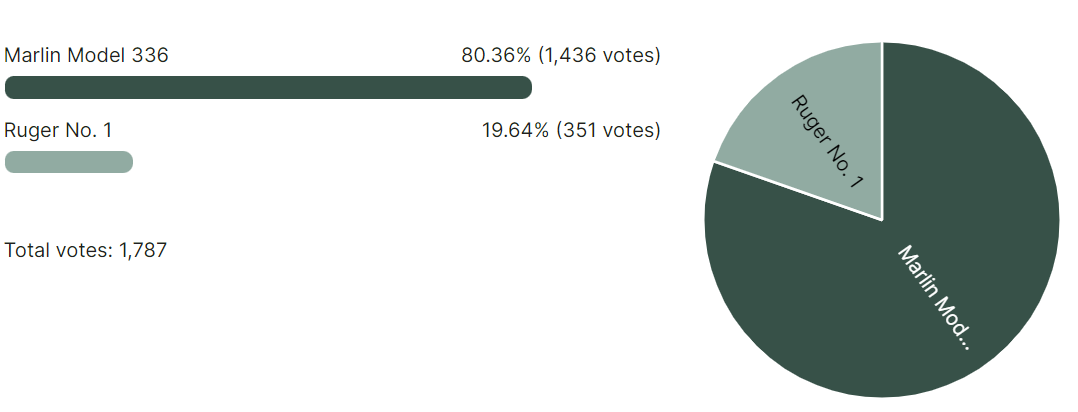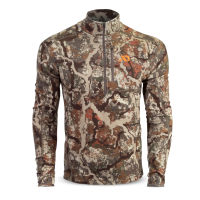
Voting for this matchup has concluded, and the Winchester Model 70 is the winner!

------------------
The first round of October Madness 2024 is in the books with strong performances from the Marlin Model 336 (80% of the vote) and the Winchester Model 70 (69% of the vote).


Now, these two iconic rifles go head to head for a chance at the Finals to face the winner of the Remington 700 vs. Savage 99 matchup. Scroll down to the poll at the bottom of this article to cast your vote, and the rifle with the most votes by 11:59pm on Thursday, October 3rd will advance to the final round. If you'd like a little more information before casting your vote, check out the cheat sheets on each rifle below. And feel free to explain your vote in the comments (or why the other side is dead wrong).

Don’t forget to vote in the other matchups, which you can do here.
Marlin 336
Originally offered in .30-30 Winchester and .32 Special, the Model 336 is also famous for being chambered in .35 Remington, which was added to the lineup in 1953. Its tubular magazine limits its offerings to round-nose cartridges, but the rifle has nonetheless been available in a huge variety of cartridges (many of which have become obsolete). Today, Ruger offers the 336 in .30-30 only.
History
Among the most famous lever-action rifles in American history, the Marlin Model 336 has been in continuous production since it hit gun store shelves in 1948. The company sold its 3,000,000th Model 336 all the way back in 1979, and the current figure is obviously much higher. The 336 is the brainchild of famous gun designer L.L. Hepburn and traces its lineage to the Models 1893, 1936, and 36.
What distinguished the 336 was a round breech bolt in place of the rectangular bolt of previous designs. Marlin claimed in marketing materials at the time that this “massive locking bolt” assured smooth feeding and was “virtually jam proof.” The design also promised greater strength and durability to handle what were at the time high-powered rifle rounds.
Remington Arms Company purchased Marlin in 2007, and Ruger bought the company from a bankrupt Remington in 2020. Ruger has since released their own take on the legendary design–the Model 336 Classic–which retains much of what Marlin fans loved (and some of what they didn’t) about the original rifle.
Features
The 336 has been offered in a huge variety of models and configurations. The original Model 336C sported a 20-inch barrel while the Model 336A featured a 24-inch barrel. The stock has a more vertical pistol-style grip rather than the Winchester 94’s straight grip stock. In 1956, Marlin began offering the 336 drilled and tapped for a scope (its side-ejection system made it an ideal candidate for this), and the famous gold trigger was added in 1959.
Original Marlin 336’s did not incorporate any kind of safety, but the infamous cross-bolt safety was added to Carbine models in 1984. This safety mechanism has been criticized by many as unnecessary and confusing, but Ruger decided to maintain it in its reintroduction.
But they also made some excellent improvements. Ruger-made 336’s feature a cold hammer forged barrel, a thinned forend, and various design and manufacturing tweaks to make the rifles more durable. For more info, check out our full review of the Ruger-made Model 336.
Availability
It’s not difficult to find a Marlin Model 336 on the used market, most of which can be had for less than $800. If you want a factory-new rifle, you may have to wait a bit longer. The demand for Ruger-made 336’s has been stout, and I’ve heard from readers lamenting the fact that they can’t be found for love or money. My best advice? Get on the waiting list now. Ruger is churning these things out every day, so it’s just a matter of time before you get your hands on one.
Winchester Model 70
The Model 70 has been available in just about every centerfire cartridge imaginable, so there’s no point in listing them all, but here are some currently available and a few coveted oldies.
History
One of the longest tenured bolt action rifles still available, the Winchester Model 70’s endurance speaks volumes to its success and reliability. Of course, its most faithful followers swear that the Pre-64 models possess a level of superiority to those that come after. Prior to 1964, the Winchester Model 70’s bolt featured a Mauser-style, or controlled feed, action. After that, Winchester decided to cut costs and go with a push feed action. Rifle hunters lamented this change (they still do), claiming that the push feed would allow for more malfunctions. But even Jack O’Connor conceded that alterations to the Model 70 proved beneficial, if not just as reliable.
Features
Besides the differences in the Pre-64 Model 70 and those after, most of these rifles feature a three-position safety, hinged floorplate, and push feed action. Newer Model 70s, however, now harken back to the Pre-64 model with a classic controlled feed claw extractor. To be honest, both actions offer great reliability and choosing one is largely a subjective matter.
The Model 70 also has a hammer forged, free-floated barrel, blade ejector, and recessed target crown. These premium features include a premium price tag, but there’s a reason the Model 70 was coined the “Rifleman’s Rifle,” and the title remains relevant now.
Availability
The Model 70 still thrives today and there are so many iterations of the rifle, that choosing one might be a daunting task. However, that’s good news. From the Featherweights and Super Grades to the Long Range MB models with synthetic stocks and fluted barrels, you can find a model that fits even the most specific needs. Prices for the Winchester Model 70s start around $1200 if you want to buy new. Of course, you can find a reliable, well-used Model 70 for about half the price if you do some pawn/gun shop surfing. Excellent-condition Pre-64 Model 70s go upwards of a few grand. My long list of rifle regrets includes a Model 70 Featherweight in .270. Like a lot of my old hunting rifles, I had little invested in the gun, but talked myself into selling it because it wasn’t my cartridge of choice.








